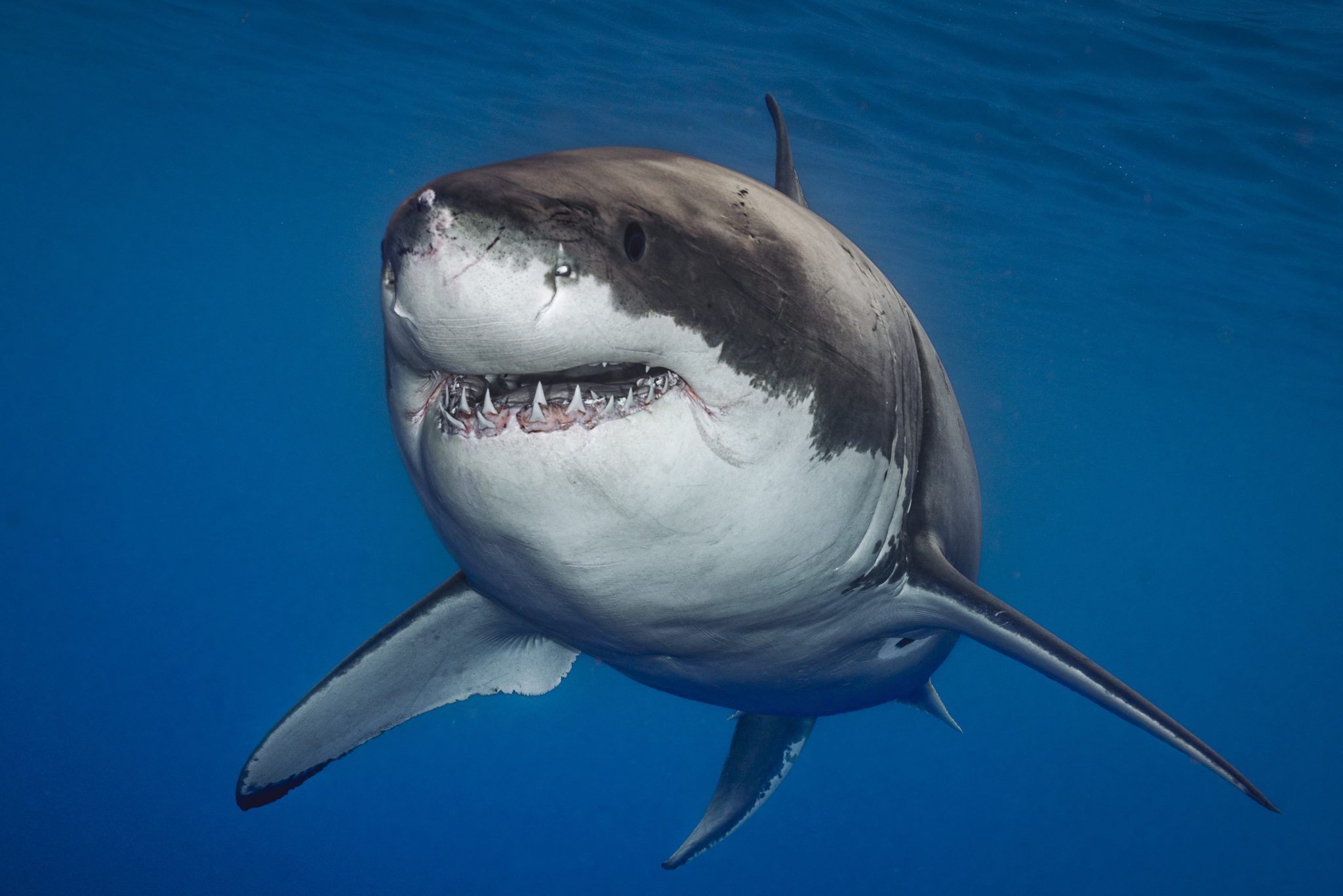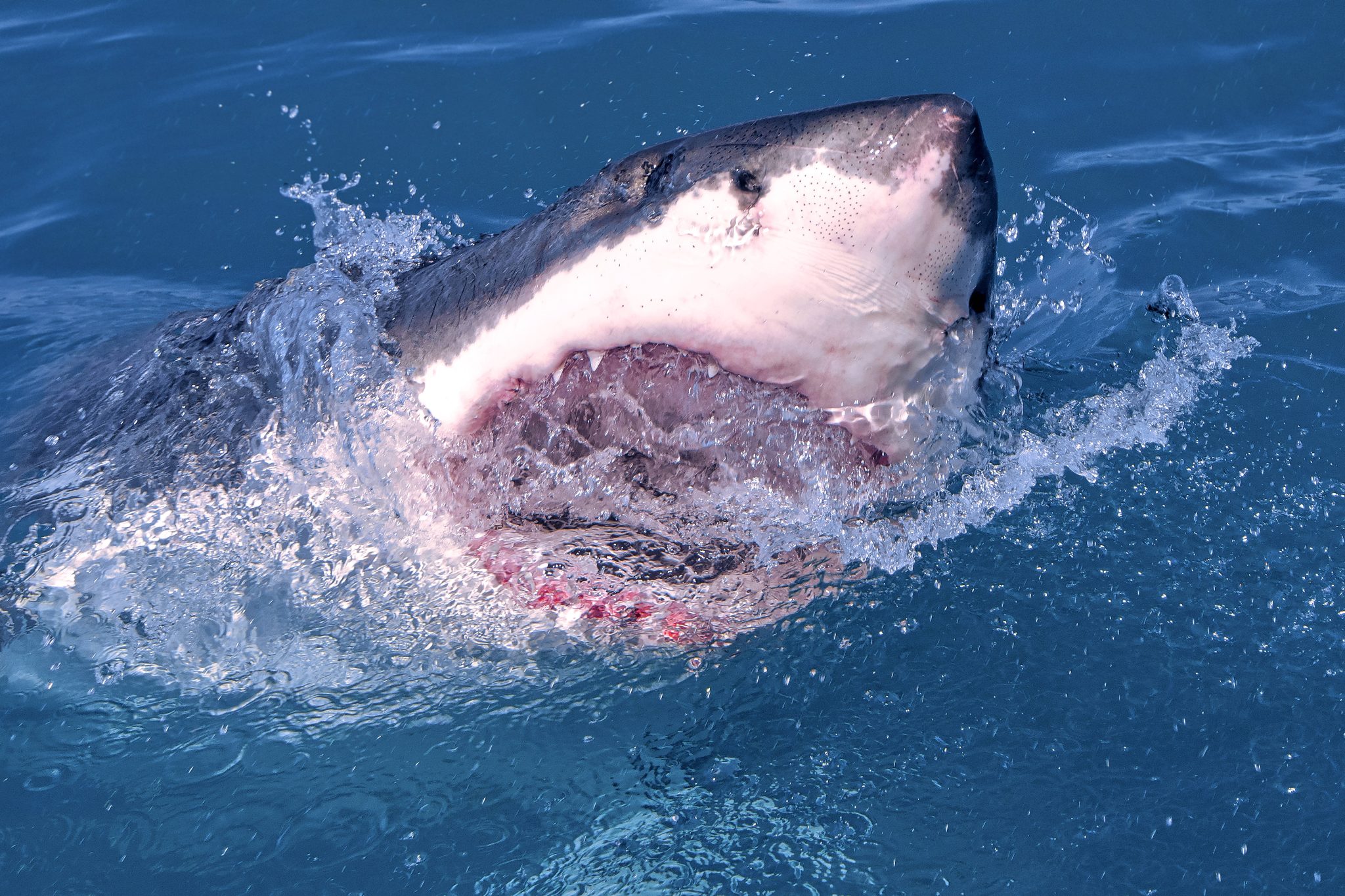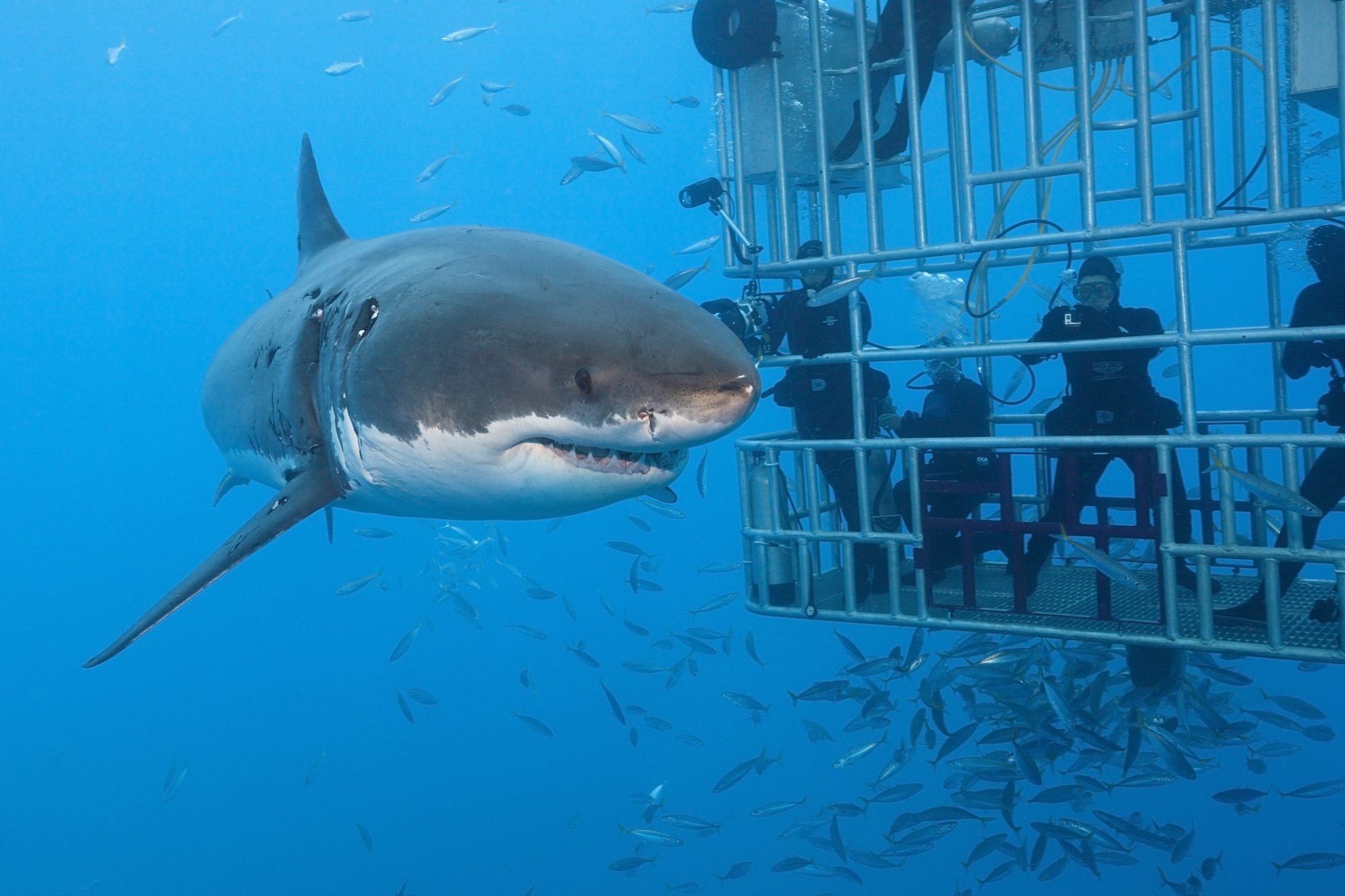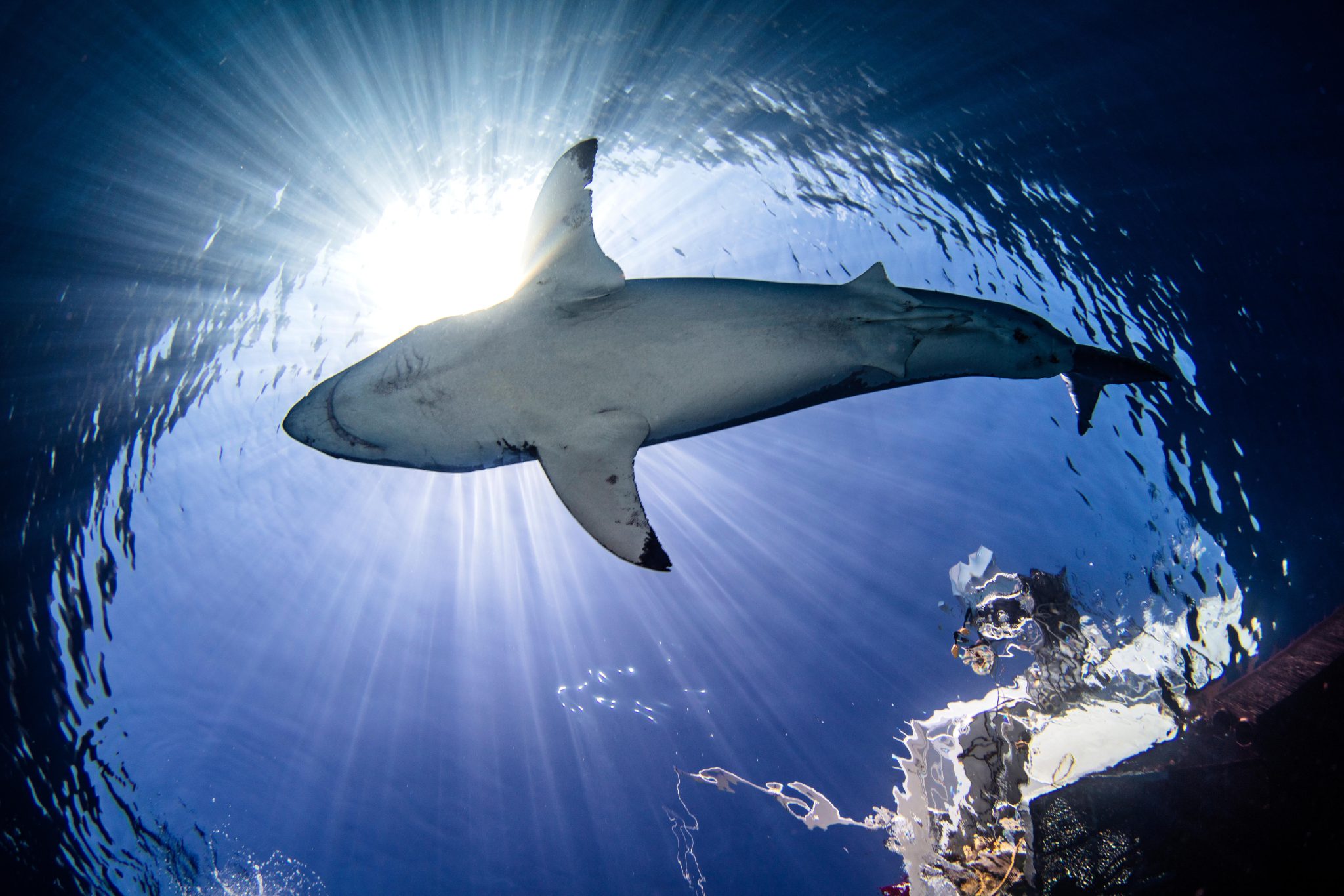Blogs
The life of a Great White Shark

The great white shark, known scientifically as Carcharodon carcharias, embodies the apex predator of the ocean. This majestic creature’s life is a testament to survival, adaptability, and the intricate balance of the marine ecosystem.
Born in the waters off coastal regions, a great white shark begins its life as a pup within the safety of nurseries, typically found in warm, shallow waters. The pups, measuring around 5 feet in length at birth, are immediately equipped with an innate instinct for survival.
As they grow, great whites embark on a journey, venturing into deeper and cooler waters, often covering vast distances across the ocean. These apex predators are perfectly adapted hunters, relying on their impressive senses to detect prey. Their acute sense of smell, aided by specialized sensory organs known as ampullae of Lorenzini, helps detect the faintest traces of blood in the water from several miles away.
Feeding primarily on seals, sea lions, and other marine mammals, great whites are known for their powerful jaws lined with rows of razor-sharp teeth. Their hunting techniques often involve stealth, utilizing their streamlined bodies to approach prey from below and striking with incredible speed and force.
Despite their fearsome reputation, great whites play a crucial role in maintaining the health of marine ecosystems. As top predators, they help regulate the population of prey species, preventing overpopulation that could disrupt the balance of the food chain.
Reproduction among great white sharks is a slow and careful process. Females reach sexual maturity between 12 and 18 years of age, while males mature earlier, around 9 to 10 years old. Mating occurs through complex courtship rituals, with females giving birth to a small number of live pups after a gestation period of about 12 to 18 months.
However, the life of a great white shark is not without challenges. Human activities, including overfishing, pollution, and habitat destruction, pose significant threats to their population. Additionally, despite their formidable presence, great whites are vulnerable and face dangers from entanglement in fishing gear and accidental bycatch.
Despite these challenges, great white sharks continue to inspire awe and fascination among scientists and nature enthusiasts. Their presence in the ocean serves as a reminder of the delicate balance and interconnectedness of marine life, emphasizing the need for conservation efforts to protect these magnificent creatures for future generations to admire and study.
Want to learn more about sharks? Visit The Shark Trust website: www.sharktrust.org
Photos: avalon.red
Blogs
Dive into Gibraltar: a Journey of Wrecks, Wildlife and Conservation

Diving in Gibraltar is an experience that truly sets itself apart. Situated at the confluence of the Atlantic and Mediterranean, it offers an underwater world rich in both marine life and history. Whether you’re a complete novice or a seasoned diver, Gibraltar is ready to take you on an unforgettable journey beneath the waves.
One of the most remarkable aspects of diving in Gibraltar is the artificial reef project. Over the years, several ships have been deliberately sunk to create vibrant underwater habitats. Among the most popular sites are the Spanish Barges, 482M, and Batty’s Barge, all located in the local favourite, Camp Bay. The Spanish Barges are a series of four wrecks, two of which were sunk as part of Gibraltar’s artificial reef programme in the 1980s. They rest at varying depths, ranging from 7 to 22 metres, making them accessible for divers of all skill levels. These wrecks, now teeming with marine life such as octopuses, conger eels, and nudibranchs, offer something for every diver, whether they enjoy swimming through wreckage or observing how marine species have transformed these vessels into thriving ecosystems.

For those more interested in history, Gibraltar’s waters host incredible wrecks like the SS Rosslyn and SS Excellent. The SS Rosslyn, a Cardiff-built steamer, sank in 1916 after dragging its anchor in a storm. Now lying at a depth of 23 metres, this 350-foot wreck attracts advanced divers eager to explore its remnants. Newer wrecks, like the Seahawk, sunk in 2002, and the Sun Swale, sunk in 2015, are part of Gibraltar’s ongoing reef expansion. These more recent additions are rapidly becoming important habitats, drawing species such as cuttlefish, spider crabs, and lobsters. Each of these wrecks offers divers the chance to experience a fusion of history and nature, with the wrecks evolving into vibrant marine environments over time.

Another must-see is the Seven Sisters Marine Conservation Zone (MCZ), known for its rich biodiversity and contribution to the protection of marine species. This area is located close to The Inkwells, where divers can still find remnants of 18th- and 19th-century artifacts, including ceramic pipes, gin bottles, marble fragments, and cod bottles, lending a treasure-hunting aspect to each dive. Exploring this site is like taking a step back in time while being surrounded by a thriving underwater ecosystem.

The diving conditions in Gibraltar are just as diverse as the marine life it hosts. British Gibraltar Territorial Waters is home to a wide array of species, far more life than many other areas in the Mediterranean. This impressive biodiversity is largely due to the nutrient-rich waters that flow where the Atlantic and Mediterranean meet. Divers frequently encounter octopuses—Gibraltar’s charismatic species—along with conger eels, moray eels, thornback rays, and spider crabs. Lucky divers, especially during certain times of the year, might even spot Bluefin Atlantic Tuna swimming through the bay while feeding, as well as many other pelagic species. The sheer abundance of fish and the variety of species make each dive an exciting and unique experience, offering something new with every descent.

Gibraltar boasts its accessibility to diving and a wealth of different dive sites depending on your diving abilities, qualifications and experience. The South and East side dive sites are fantastic boat dives ranging in depths from 14m to 35m + where you can dive on rocky biogenic reefs with a vast array of marine life.

You will need a permit to dive which is easily issued by the Department of the Environment or you can dive with licenced dive operators who will cover this for you. There are also very active local BSAC dive clubs you may wish to get in touch with.

Gibraltar offers a full range of diving experiences for everyone, from first-timers to seasoned veterans. Shore diving is conducted six days a week, and on Sundays, you may venture out on a boat to explore some of the more distant wrecks, such as SS Rosslyn and Sun Swale. What makes diving in Gibraltar so accessible is that all our dive sites are within a 15-minute drive/boat ride, making it easy to fit multiple dives into a single day. Whether you’re taking your first steps into the underwater world with a try dive or you’re an advanced diver looking to explore wrecks and caves, we ensure that each dive is tailored to suit your needs and experience level.

Operations start early, and by 8:45 AM, dive centre teams are already busy preparing for the day’s dives ensuring everything is in place for divers. A typical dive day begins with a briefing that covers the dive plan, safety procedures, and site management, ensuring that everyone is comfortable and prepared for the adventure ahead. Whether it’s exploring historic wrecks or spotting charismatic marine life, each dive offers something special. After the first dive, you surface, switch tanks, and enjoy a surface interval sharing stories of what has been seen before briefing up for a second dip!

In addition to providing unforgettable diving experiences, Gibraltar is deeply committed to marine conservation and scientific research working closely with the Department of the Environment and the University of Gibraltar. Under the water we facilitate the university’s research on projects including coral health assessments and the transplantation of coral species such as Astroides calycularis and various gorgonians. These efforts are critical in preserving Gibraltar’s underwater ecosystems and ensuring that future generations of divers can enjoy its incredible biodiversity. These conservation initiatives are ongoing, and there is regular collaboration with students and researchers on various dive-related projects as they begin the Thesis modules of their degrees.

Dive Charters, Gibraltar’s predominant dive centre is also involved in some octopus research, with a project aimed at increasing the octopus population in Gibraltar’s waters. Working with the University of Gibraltar and the Department of the Environment, they have installed artisanal dens designed to encourage octopus to breed and thrive in the area. These dens have proven highly successful, and divers often encounter octopuses up close in their natural habitat. Observing these intelligent, curious creatures in action is always a highlight of our dives, and their growing population is a testament to the ongoing conservation work.

Diving in Gibraltar offers an unparalleled blend of history, marine life, and conservation. Whether you’re captivated by centuries-old shipwrecks or amazed by the diversity of species that call these waters home, Gibraltar provides a diving experience like no other and we are proud to share this incredible underwater world with divers from all over the globe. Our dedication to safety, fun, and environmental responsibility ensures that each dive leaves a lasting impression.

From beginners to experienced divers, we’ve got something for everyone. With all dive sites just a short ride away the wonders of Gibraltar are waiting for you!

|
|
|
Blogs
Saba’s Plan for a Coral Comeback

Saba has an exciting new initiative to restore its coral reefs. This new project, running from 2024 to 2026, will focus on reviving key species in the island’s underwater ecosystems. With a collaborative team from the Saba Conservation Foundation (SCF) and Van Hall Larenstein (VHL) University of Applied Sciences, the project aims to restore both corals as well as sea urchins.
This initiative is centered around coral restoration, specifically reviving two essential coral species—staghorn coral (Acropora cervicornis) and elkhorn coral (Acropora palmata). By mapping parent colonies and using a technique known as coral gardening, SCF will create and maintain coral nurseries. These corals will eventually be outplanted at key reef sites around Saba to not only expand the number of coral colonies, but also provide essential fish habitat. The project focusses on installing coral nurseries, training staff with the newest techniques and starting with the restoration of key reef sites.

Reef Cleaners to the Rescue
It’s not just corals getting a makeover—this project also shines a spotlight on the essential role of grazers, particularly sea urchins. VHL is leading the charge on cultivating and restocking two key sea urchin species, West Indian sea egg (Tripneustes) and long-spined sea urchin (Diadema), known for their ability to keep algae in check. By removing algae, which are important competitors of corals, they help the coral to thrive. By restoring these “reef cleaners,” Saba’s project will give corals the breathing room they need to grow, setting the stage for a healthier, more balanced marine ecosystem.
From Tiny Urchins to Big Goals
The project will be funded as part of the Dutch Government’s Nature and Environment Policy Plan (NEPP) 2020-2030 for the Caribbean Netherlands, a comprehensive initiative aimed at conserving and restoring the unique natural environments of the Dutch Caribbean islands, including Saba, St. Eustatius, and Bonaire. This project is aiming for big milestones: build and maintaining coral nurseries, the expansion of urchin cultivation facilities, and the creation of a dedicated research center. By 2026, the project hopes to ramp up coral and grazer restoration, with the ultimate goal of extending these efforts across the Dutch Caribbean. By linking local initiatives to broader regional goals, Saba’s restoration project promises to leave a lasting impact on both the environment and the community.
Find out more about the DCNA at dcnanature.org.
-

 Blogs2 months ago
Blogs2 months agoGozo: An Underwater Treasure Trove in the Heart of the Mediterranean
-

 News1 week ago
News1 week agoIconic SS United States to become the World’s Largest Artificial Reef
-

 Blogs2 months ago
Blogs2 months agoNovoScuba’s Game-Changing Approach for Dive Store Owners: WE PAY YOU!
-

 News1 month ago
News1 month agoBook Review – 52 Assignments: Underwater Photography
-

 News3 months ago
News3 months agoDived Up release NEW Second Edition of Diving Gozo & Comino by Richard Salter
-

 News3 months ago
News3 months agoTreasures, Shipwrecks and the Dawn of Red Sea Diving by Howard Rosenstein available now
-

 Marine Life & Conservation2 months ago
Marine Life & Conservation2 months agoBook Review: Sharkpedia
-

 Gear News1 month ago
Gear News1 month agoDYNAMICNORD – New German diving brand enters the British market


















